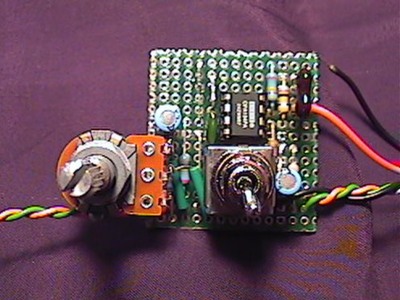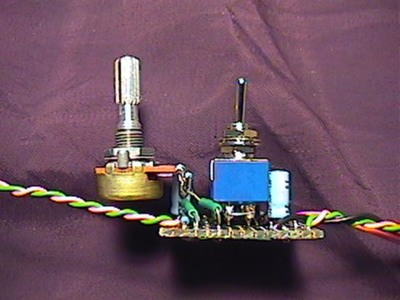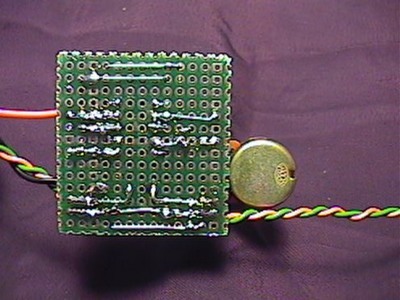Building an Onboard Opamp Based Guitar Preamp
By Paul Marossy
Last
Updated 12/30/05
I first saw this preamp circuit in "The Guitar Handbook" by Ralph Denyer about 1988. I
was always intrigued by the circuit even before I had an interest in electronics. The first
time I built this circuit, it was a failure. Recently I decided to revisit this project and
I'm glad that I did. It actually worked this time!
The circuit is very simple, and uses a single opamp in a non-inverting configuration. It can be built
on a piece of veroboard or perfboard measuring 1.5"x1.375". There aren't any specs given on the circuit
other than the 50K will adjust the gain from two to ten times the input signal. Power supply is a
9V battery. As far as the actual performance of the circuit goes, I am pleasantly surprised. It
sounds pretty good in spite of the fact that I hear all the time that FET preamps are the only
way to go. It has a clean sound but doesn't sound sterile, and a low noise level, depending on which opamp you use. Even with
the gain turned up all the way, it doesn't distort, even with a hot humbucking pickup. And with the
gain control at maximum, it gives a nice push to whatever you are plugged into - it could be handy
to help coax an amp into distortion easier. I think it could even be placed in an external box and used
in a fashion similar to a booster pedal.
Here are some pictures of my project:
This is the top view. I built it exactly per the layout in the book, except that
I did it on a piece perfboard instead. For the gain control, I used a regular pot instead
of a trimpot so I could have maximum flexibility with minimum hassle. The opamp I used is a
Burr-Brown OP134A and works very well in this circuit. Other opamps that could be used
include a TL071, NE5534 and other loise noise opamps. A 741 opamp is not recommended as it is
really a bit too noisy for audio circuits - at least for a guitar preamp it is.
This is the side view. Here I have the bypass switch and the gain pot wired
directly to the circuit board, for a pair of mounting holes spaced 1.125" apart. The switch
and pot hold the circuit board in place when installed in the guitar. Of course,
this could be wired several other different ways, depending on the guitar that it is going to
be placed in.
This is the bottom. There is a minimum amount of soldering required for this simple project.
It took about an hour or so to complete the circuit board and wiring connected to it.
Here is the circuit board next to the drawing in the book. Looks just like the
drawing, huh? I haven't decided if this will go in any of my guitars or if it will
be placed in an external box, but I am sure I will be using it one way or the other.
The only negative thing about this preamp circuit (as with any other preamp
circuit) is that it would not be real practical on a Strat style electric because
it would require you to remove all the strings, and thirteen
screws to remove the pickguard to get to the battery. I used to
have a '77 Fender fretless P-Bass that had a preamp installed in
it, done by the previous owner, and it was a pain to change the
battery! It was the same process as a Strat would be... For a
Strat style guitar, an external box of some sort may be a better
way to go.
I did have a little trouble getting it to work initially - it seems to be picky about the opamp
that you use, but it does work well with a TL071 and a OP134A. The other quirky problem I had is
that when it was switched from bypass mode to preamp mode, there would be a delay of about 1/2
second before you would hear sound. When in bypass mode, C1 is uncharged. When the circuit is
switched to preamp mode, capacitor C1 has to charge to 4.5 volts - through the volume control
and the 470 K resistor, producing a voltage at the input of the preamp. I'm not sure if this
overloads the opamp or what it's doing exactly, but the solution for this problem is very simple - placing a 10M resistor to
ground before the input cap will effectively solve this problem. That said, if you are
considering building an on-board preamp for your electric guitar,
you should consider this simple little circuit - it's inexpensive, easy to build and works well.



